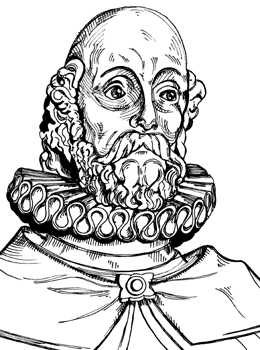 |
 |
|||
|
|
 Sir
Henry Norreys (1525-1601) Sir
Henry Norreys (1525-1601)Born: 1601 possibly at Yattendon, Berkshire Baron Norreys of Rycote Death: 27th June 1601 at Rycote, Oxfordshire Henry was son and heir of Henry Norreys (d. 1536) - who was executed and attainted as the alleged lover of Anne Boleyn - and his wife, Mary Fiennes, daughter of Thomas, Lord Dacre. He seems to have been born about 1525. His age was officially declared in 1564 to be only thirty, but this statement is irreconcilable with the records of his early years. Henry VIII restored to him much of his father's confiscated estate, "with some strict conditions respecting the estate of his grandmother, who was one of the heirs of Viscount Lovel". As a young man he seems to have become an attendant in the private chamber of King Edward VI and to have sat in Parliament in 1547 as MP for Berkshire. He signed, on 21st June 1553, the letters patent drawn up by the Duke of Northumberland in order to limit the succession to the Crown to Lady Jane Grey. In early life, before 1545, he married Margery the daughter of John Williams, who was created Lord Williams of Thame in 1554. During Queen Mary's reign, Norreys resided at Wytham 'Abbey' in Berkshire, one of his father-in-law's manors. In 1566, the site and lands of the monastery of Little Marlow in Buckinghamshire were alienated to Norreys and Lord Williams jointly. Williams' death in 1559, put Norreys and his wife into possession of the estate and manor-house of Rycote, near Thame in Oxfordshire, where he chiefly resided thenceforth. Williams had shared, with Sir Henry Bedingfield, the duty of guarding Princess Elizabeth while she was imprisoned at Woodstock during her sister's reign. He had treated the princess leniently, had invited her occasionally to Rycote and his kindness was gratefully remembered by Elizabeth. She consequently showed, after her accession to the throne, exceptional favour to Norreys and his wife. The latter, she playfully nicknamed her 'black crow' in reference to her dark complexion. Nor was Elizabeth unmindful of the fate of Norreys' father, whom she believed to have sacrificed his life in the interests of her mother, Anne Boleyn. She, at once, restored to him all the property which Henry VIII had withheld. The attentions Elizabeth bestowed on Norreys and his kinsfolk excited the jealousy of Sir Francis Knollys and his sons whom, being her cousins, she also admitted to friendly relations. The bickering at court between the two families continued throughout her reign. In 1561, Norreys was Sheriff of Oxfordshire and Berkshire. In 1565, he took part in a tournament in the Queen's presence on the occasion of the marriage of Ambrose Dudley, Earl of Warwick. In September 1666, the Queen visited him at his house at Rycote on her return from Oxford, and knighted him before her departure. In the autumn of 1566, she appointed him Ambassador to France. Norreys did what he could to protect the French Protestants from the aggressions of the French Government but, early in 1570, warned the English Ministers that the French Government threatened immediate war with England if Elizabeth continued to encourage the Huguenots in attacks upon their princes. Although he fulfilled his duties prudently, he was recalled in August 1570 to make way for Sir Francis Walsingham, who was commissioned to make a firmer stand on behalf of the French Protestants. By way of recompense for his services abroad, Norreys received a summons to the House of Lords, as Baron Norreys of Rycote, on 8th May 1572. In September 1582, he was disappointed by a promised visit from the Queen to Rycote, and was not well pleased when Leicester arrived in her stead; but his guest wrote that Norreys and his wife were "a hearty noble couple as ever I saw towards her highness". In September 1592, the Queen revisited Rycote on another journey from Oxford. In October 1596, Norreys was created Lord Lieutenant of Oxfordshire. He already held the same office for Berkshire. In 1597, the grief of Norreys and his wife upon the death of their distinguished son, Sir John, was somewhat assuaged by a stately letter of condolence from the Queen to "my own dear crow," as Elizabeth still affectionately called Lady Norreys. Norreys died in June 1601 and was temporarily buried, on the 21st, in the church at Englefield, where his son Edward was living. Finally, on 5th August, he was re-interred at Rycote, in a vault beneath the chapel of St. Michael and All Angels, which was founded in 1449 by Richard Quatremains and Sybilla, his wife, in the grounds of Rycote House. The chapel, now open to the public as a historic monument, remained the chief burial place of the Norreys' and their descendants, the Berties, until about 1886. The house at Rycote was burnt down in 1747, but some remnants of it form part of the fabric of the later farmhouse which now occupies its site. Norreys' will was dated 24th September 1589. His wife died in December 1599 and both she and himself are commemorated by the monument erected in honour of them and their six sons in St. Andrew's Chapel in Westminster Abbey. Life-size figures of Lord and Lady Norreys lie beneath an elaborate canopy supported by marble pillars and they are surrounded by kneeling effigies of their children. "Although himself of a meek and mild disposition," Camden says that Norreys was father of "a brood of spirited, martial men". His six sons - especially John and Thomas - all distinguished themselves as soldiers, fighting in France, Ireland or the Low Countries. Norreys outlived five of them; Edward alone surviving his parents. Edited from Sidney Lee's 'Dictionary of National Biography' (1895)
|
|||
| © Nash Ford Publishing 2002. All Rights Reserved. | ||||


